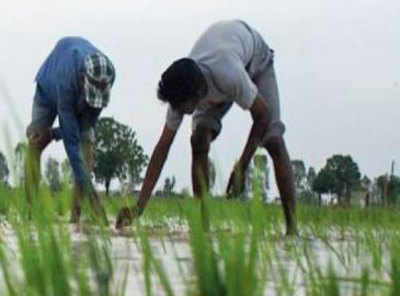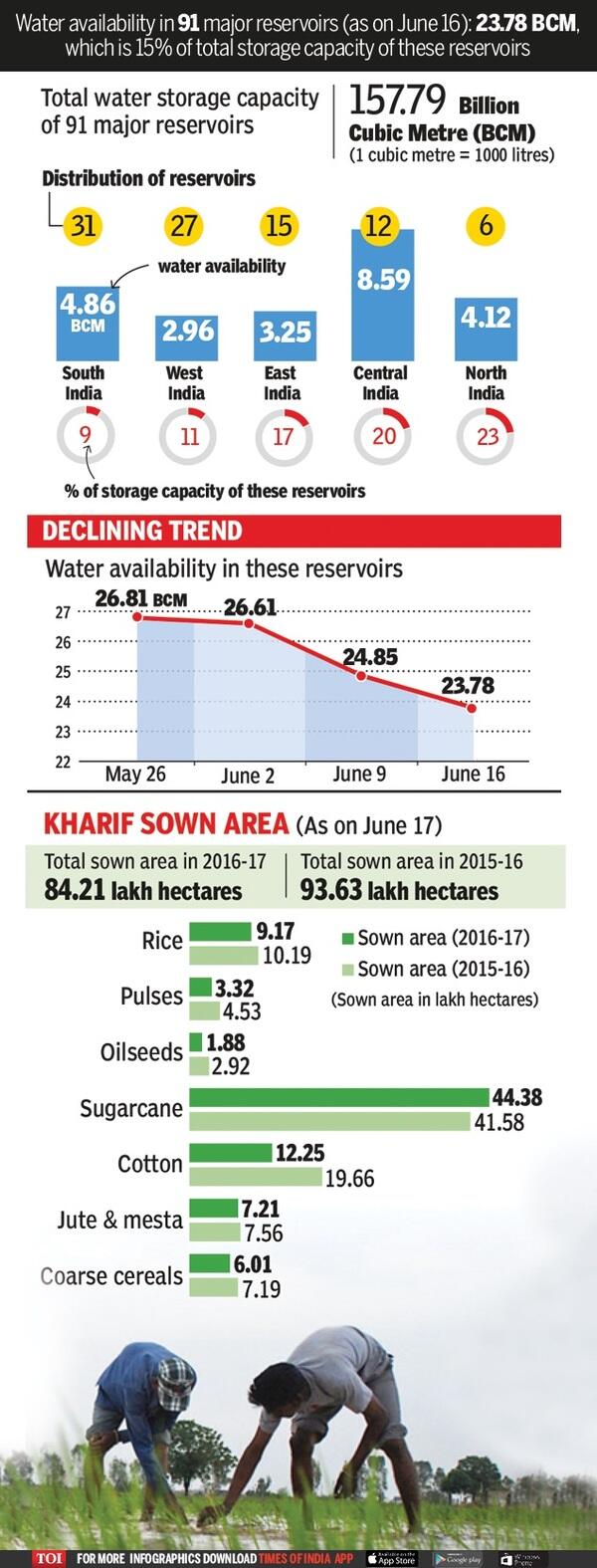- News
- India News
- Just 15% water left in 91 major reservoirs
Trending
This story is from June 18, 2016
Just 15% water left in 91 major reservoirs
The slow progress of the monsoon has meant water storage in 91 major reservoirs has dipped further and overall availability stands at just 15% of capacity.

Key Highlights
- Overall availability stands at just 15% of capacity.
- Initial kharif sowing and availability of drinking water hit.
- Water levels in reservoirs dip from 26.81 BCM to 23.78 BCM.
NEW DELHI: The slow progress of the monsoon has meant water storage in 91 major reservoirs has dipped further and overall availability stands at just 15% of capacity. This has not only hit initial kharif sowing but also availability of drinking water.
Though the area under kharif will increase once rains sweep the entire country over the next few weeks, the current water shortages have shrunk the total area under rice, pulses, oilseeds and other crops, except sugarcane.As on Friday, the sown area under kharif crops was 10% less than that in the same period last year.
Water levels in key reservoirs dipped from 26.81 billion cubic metres on May 26, to 23.78 BCM on June 16.
With water levels in key reservoirs already at worrying levels, the situation could turn desperate if the monsoon fails to pick up in the next four-five days.
Comparatively, the situation in the north is much better with water levels in the region’s six major reservoirs at 23% of capacity.
Of the 91 big reservoirs monitored by the CWC, 27 are in the west, 15 in east and 12 in central India.
Besides supplying drinking water to many cities and providing water for irrigation, 37 of these 91 reservoirs have hydropower facilities with installed capacities of more than 60 MW.

The total kharif sown area stood at 84.21 lakh hectares on Friday as compared to 93.63 lakh hectares at the same point last year. Surprisingly, the sown area under water-guzzling sugarcane as on June 17 was higher than its acreage last year — signaling farmers’ preference for the crop that invariably gives better returns than pulses and oilseeds. In fact, sugarcane has already occupied more than 50% of the total sown area.
The NDA government’s move to substantially reduce the dues of sugarcane farmers in the past two years also seems to have played a role in tilting the cropping pattern in favour of sugarcane. About 87% of the dues have already been paid for the 2015-16 season, indicating how the crop remains remunerative despite delays in payment by sugar units.
The country had recorded monsoon deficits of 12% and 14% in 2014 and 2015, respectively. Though it is normal for water bodies to deplete sharply in the pre-monsoon summer months, the CWC has been keeping a close watch on the storage in these reservoirs so that the available water can be distributed properly till the arrival of monsoon.
Most of these reservoirs get water during the June-September southwest monsoon, while reservoirs in Tamil Nadu get water during the October-December northeast monsoon.Reservoirs being monitored by CWC include Gobind Sagar (Bhakra) and Pong Dam in Himachal Pradesh, Thein in Punjab, Rana Pratap Sagar in Rajasthan, Panchet Hill in Jharkhand, Hirakud and upper Indravati in Odisha, Ukai and Sardar Sarovar in Gujarat, Koyana and upper Vaitarna in Maharashtra etc.
Though the area under kharif will increase once rains sweep the entire country over the next few weeks, the current water shortages have shrunk the total area under rice, pulses, oilseeds and other crops, except sugarcane.As on Friday, the sown area under kharif crops was 10% less than that in the same period last year.
Water levels in key reservoirs dipped from 26.81 billion cubic metres on May 26, to 23.78 BCM on June 16.
With water levels in key reservoirs already at worrying levels, the situation could turn desperate if the monsoon fails to pick up in the next four-five days.
Reservoirs in south India are the worst affected. Central Water Commission figures, released on Friday, show that water availability in 31 reservoirs in the south was 4.86 BCM on June 16 — just 9% of capacity.
Comparatively, the situation in the north is much better with water levels in the region’s six major reservoirs at 23% of capacity.
Of the 91 big reservoirs monitored by the CWC, 27 are in the west, 15 in east and 12 in central India.
Besides supplying drinking water to many cities and providing water for irrigation, 37 of these 91 reservoirs have hydropower facilities with installed capacities of more than 60 MW.

The total kharif sown area stood at 84.21 lakh hectares on Friday as compared to 93.63 lakh hectares at the same point last year. Surprisingly, the sown area under water-guzzling sugarcane as on June 17 was higher than its acreage last year — signaling farmers’ preference for the crop that invariably gives better returns than pulses and oilseeds. In fact, sugarcane has already occupied more than 50% of the total sown area.
The NDA government’s move to substantially reduce the dues of sugarcane farmers in the past two years also seems to have played a role in tilting the cropping pattern in favour of sugarcane. About 87% of the dues have already been paid for the 2015-16 season, indicating how the crop remains remunerative despite delays in payment by sugar units.
The country had recorded monsoon deficits of 12% and 14% in 2014 and 2015, respectively. Though it is normal for water bodies to deplete sharply in the pre-monsoon summer months, the CWC has been keeping a close watch on the storage in these reservoirs so that the available water can be distributed properly till the arrival of monsoon.
Most of these reservoirs get water during the June-September southwest monsoon, while reservoirs in Tamil Nadu get water during the October-December northeast monsoon.Reservoirs being monitored by CWC include Gobind Sagar (Bhakra) and Pong Dam in Himachal Pradesh, Thein in Punjab, Rana Pratap Sagar in Rajasthan, Panchet Hill in Jharkhand, Hirakud and upper Indravati in Odisha, Ukai and Sardar Sarovar in Gujarat, Koyana and upper Vaitarna in Maharashtra etc.
End of Article
FOLLOW US ON SOCIAL MEDIA










